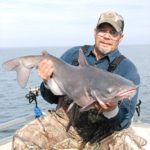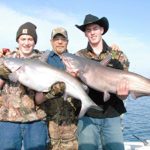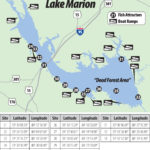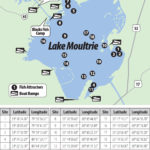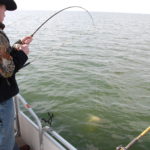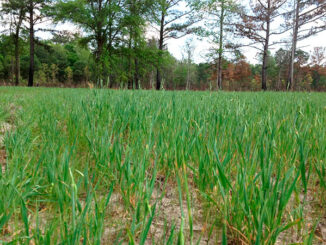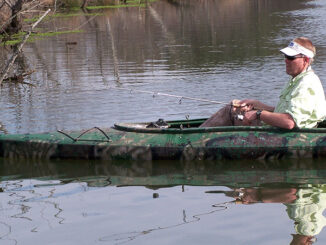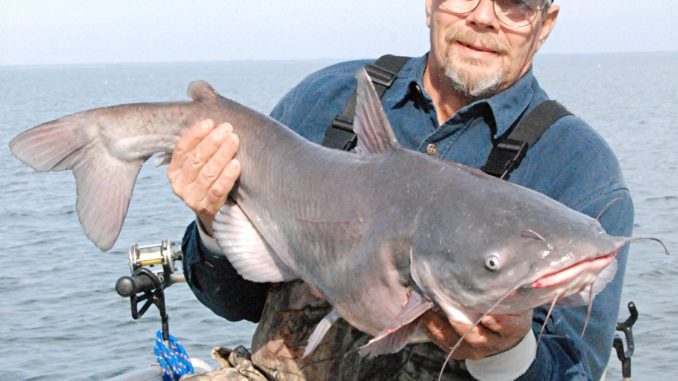
Stump-jumping and drifting are productive ways to catch Santee Cooper blue catfish as Christmas approaches.
Veteran fishermen debate over the best time of year to target blue catfish on the Santee Cooper lakes. Some argue for April, when big blues move shallow to spawn. Others point to June, when blues continually graze on mussel beds. Another argument can be made that February is best, as anglers claim it never gets too cold for blue cats.
Spencer Edmonds’ vote is for December. A catfish guide, Edmonds said that this month, blues will begin shadowing roaming schools of baitfish, waiting on water temperatures to fall and drop a feast, literally, on their heads.
As the water temperature drops, older water causes threadfin and gizzard shad in Lake Marion and Lake Moultrie to stack up in deeper water. As the temperatures continue to drop, the baitfish become stressed and weakened, making them an easy meal for hungry catfish, which need to stock up on their fat reserves for the winter. The result can be some of the best catfishing of the year.
Edmonds has a game plan depending upon which lake he intends to fish. If he’s fishing the upper lake, Marion, he uses a tactic he refers to as “stump-wrangling” — essentially tying up to a piece of old standing timber that is still visible in the Lake Marion forebay. If Moultrie, the lower lake, is his destination, Edmonds will drift with the wind using specialized tactics and gear.
On either side of the Santee River channel on the lower end of Lake Marion is an area of dead forest, flooded timber left standing in the middle of the lake when it was built. While some of the trunks are still visible above water, Hurricane Hugo managed in 1989 to break off a majority of the old timber at or just below the waterline. For this reason Edmonds suggests that boats should operate just above idle speed when making their way into the forest.
“When the baitfish move out into the dead forest on Lake Marion, that’s the best time to ease in there and do some stump-jumping,” Edmonds said. “I decide which area to fish by paying close attention to my graph. It all may look the same, but you want to find those old creek channels that wind through the dead forest and look for pods of bait holding in there. Then you set up right on the edge of the channel.”
Rather than anchoring his pontoon boat, Edmonds will lasso one of the visible trunks. After years of fishing this way, Edmonds can recognize his best fishing areas by site. Like most fishermen, he even has pet names for his favorites.
With a rope around one of the trunks, Edmonds prefers not to anchor the rear of the boat. He said catfish are not particularly spooky, but the less invasive he can be, the better his chances of getting on the fish.
“There’s no need to anchor the back if there’s enough wind to keep the boat steady,” he said. “Otherwise just drop an anchor straight down; that’s enough to hold it in place.”
Edmonds typically sets up rods using fresh cut shad on a 2- to 4-ounce Carolina- rig dropped straight down on either side of the tie-down tree. He positions the baits three turns of the reel handle off the bottom, then fan-casts several other lines from the bow around the boat’s perimeter. He places each rod in a rod holder with reels engaged but allows enough slack to let the line billow out and give the fish time to take the bait.
“You want to try to arrange the baits so that they are at different depths,” Edmonds said. “By casting some lines out away from the boat in all directions and some of the baits straight down — especially right beside these old trees — I’m trying to cover all the bases.”
For bait, Edmonds uses a variety of whole gizzard shad and 10- to 12-inch blueback that he catches the night before and keeps on ice in a small cooler. He said if he doesn’t get a bite within 30 minutes of setting up, he’ll move on to another spot, hence the term “stump-jumping.”
Edmonds takes an entirely different approach to Lake Moultrie in December. Unlike Marion, which is an impounded river, Moultrie is at its most-basic level, a flooded swamp. Water was diverted from the Santee system to flood the area, and without an arterial river system, Moultie can be a veritable mosh pit for blue catfish.
“Catfish can be about anywhere on Moultrie, which is why I drift fish for them,” Edmonds said. “I have had some good days in November and December drifting on the lower lake. Birds are also always a key factor. If they’re in the water, diving and raising Cain, they’re feeding on bait. You get around the bait, you’re going to be around some catfish.”
Edmonds side-drifts from his pontoon, using the wind to push his boat across the lake while he controls the speed with drift socks. Along the way, he’s dragging Santee drift rigs, mining the bottom for catfish.
“What I do is drift according to the wind direction,” he said. “I like to drift down the slope. I’ll start in 24 feet of water, drift ’til I get down to as much as 50 feet of water. Fish sink for some reason and, when the weather gets cooler, the fish seem to move down to that deeper water closer to the dam.”
Edmonds bait and tackle, minus the rig, is the same he uses for stump wrangling on Marion. He favors stout, 30-pound tackle and reels spooled with 60- to 80-pound braided line.
“I’m using 80-pound braid with 50-pound monofilament leaders,” he said. “I use Ambassador 6500 reels combined with mostly Ugly Stick catfish rods. You need that stout tackle to get some of these big blues we have in these lakes to the boat so that they’ll still be in good shape to release them.”
The blue catfish population on the Santee Cooper did not occur overnight. The process of building the fishery began in 1964 and 1965 with two separate stockings totaling only 180 catfish. South Carolina traded striped bass fingerlings to Arkansas for its popular blue catfish.
The fishery grew like wildfire in the fertile waters of the Santee Cooper lakes, hitting its heyday during the late 1980s and staying great through 2000. Fisheries biologist Scott Lamprecht of the S.C. Department of Natural Resources said his department began noticing something was amiss with the fishery around 2004.
“We can clearly show from our fish samplings that the number of fish less than 20 inches have just fallen off the table since 2005, just a big decline. You’re looking at least a 10-fold decline,” Lamprecht said. “It’s clearly a problem of recruitment. The number of fish above 20 inches far exceeded the long-term average. Even today, we’ve still got big fish out there, but our densities of fish are way off.”
DESTINATION INFORMATION
HOW TO GET THERE — Access to Lake Marion and Lake Moultrie is readily available through a number of both public and private pay launch sites. Public boat access areas can be found at www.santeecooper.com/portal/page/portal/SanteeCooper/Environment/Recreation. Click on the public boat ramps list to open a map.
TACKLE/TECHNIQUES — Stump-jumping through Lake Marion’s “dead forest” is a popular technique; tie up to a piece of timber that’s still protruding through the lake’s surface and fan-cast cut baits around the boat. Move if you don’t get bites pretty quickly. On Lake Marion, drift with the wind, controlling the speed of the boat by using drift socks. Use Santee drift rigs and cut bait. In both cases, use your electronics to look for areas holding concentrations of baitfish. Heavy tackle is a key; go for heavy action Ugly Stik Catfish rods and ABU 6500 reels spooled with 50- to 80-pound braid.
FISHING INFO/GUIDES — Spencer Edmonds, S & S Fishing Guide Service, 803-516-1772, www.sandsfishingguide.net; Scott Lamprecht, SCDNR, 843-825-3387, LamprechtS@dnr.sc. gov. See also Guides and Charters in Classifieds.
ACCOMMODATIONS — Santee Cooper Country, 800-227-8510, www.santeecoopercountry.org; Blacks Camp, 843-753-2231, www.blackscamp.com; Bells Marina, 803-492-7924, www.bellsmarina.com; Rock’s Pond Campground, 803-492-7711, www.rockspondcampground.com; Canal Lakes Fish Camp, 843-753-2271, www.canallakesfishcamp.com.
MAPS — Delorme South Carolina Atlas & Gazetteer, 800-561-5105, www.delorme.com; Kingfisher Maps, 800-326-0257, www.kingfishermaps.com; Fishing Hot Spots, 800-ALL-MAPS, www.fishinghotspots.com.

